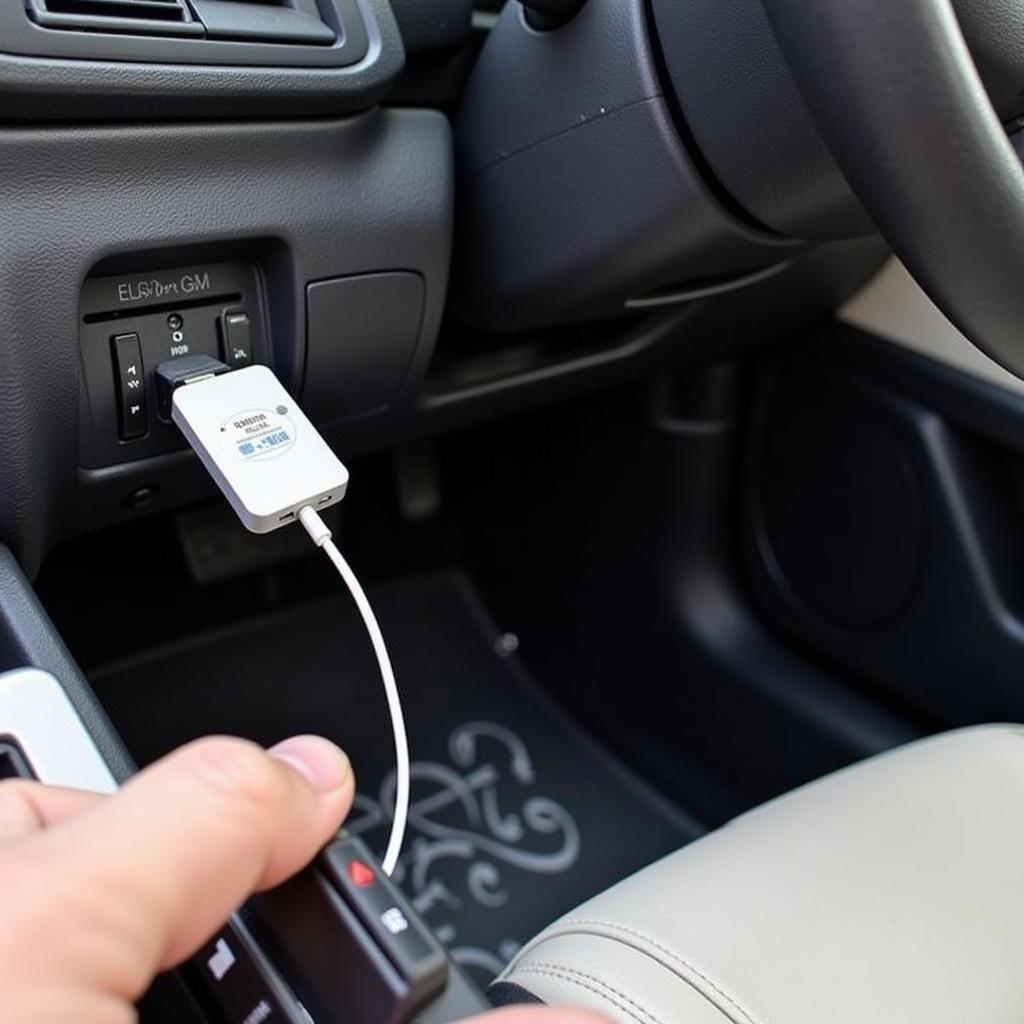A Bidirectional Car Scanner, also known as a bidirectional scan tool, is an essential tool for any car enthusiast or professional mechanic. Unlike traditional OBD2 scanners that only read error codes, a bidirectional car scanner can interact with your vehicle’s systems, allowing for more in-depth diagnostics and troubleshooting. This article will explore the world of bidirectional car scanners, their benefits, and how they can be used for various automotive applications.
[image-1|bidirectional-scanner-diagnostics|Bidirectional scanner performing diagnostics| A mechanic using a bidirectional car scanner to diagnose a car’s engine problem. The scanner is connected to the car’s OBD-II port, and the mechanic is reviewing the data displayed on the scanner’s screen.]
Why Choose a Bidirectional Car Scanner?
A common question among car owners is, “Do I need a bidirectional car scanner?” The answer, particularly for those who enjoy hands-on car maintenance or want a deeper understanding of their vehicle’s health, is often a resounding yes. Here’s why:
- Advanced Diagnostics: Bidirectional scanners go beyond simply reading error codes. They can access and interact with various vehicle systems, allowing you to pinpoint the root cause of issues more efficiently.
- Component Testing: These scanners can activate components like fuel injectors, solenoids, and even windows, helping you verify their functionality and isolate faults.
- Coding and Programming: Some bidirectional scanners support coding and programming functions, enabling you to perform tasks like key fob programming, injector coding, and more.
- Time and Money Savings: By identifying problems accurately, bidirectional scanners can save you time and money on unnecessary repairs and multiple trips to the mechanic.
How Bidirectional Scanners Work
Bidirectional scanners work by establishing two-way communication with a vehicle’s Electronic Control Units (ECUs). They use the OBD-II port, a standard connector found in most cars manufactured after 1996, as the access point.
Here’s a simplified breakdown of the process:
- Connection: The scanner connects to the vehicle’s OBD-II port.
- Communication: The scanner sends requests to specific ECUs within the vehicle.
- Data Exchange: The ECUs respond to the requests, transmitting data back to the scanner. This data can include live sensor readings, error codes, and other relevant information.
- Control: With bidirectional capability, the scanner can also send commands to activate specific components or functions within the vehicle.
[image-2|mechanic-using-scanner-troubleshooting|Mechanic using scanner for troubleshooting| A mechanic in a repair shop is shown using a bidirectional scanner to troubleshoot a complex electrical issue in a car. He’s looking at the screen which displays various parameters and data streams.]
Features to Look for in a Bidirectional Car Scanner
The market offers a wide array of bidirectional car scanners, each with its own set of features and capabilities. When choosing a scanner, consider the following factors:
- Vehicle Compatibility: Ensure the scanner supports your vehicle’s make, model, and year.
- Software Features: Look for scanners with user-friendly software, comprehensive diagnostic capabilities, and features specific to your needs, such as coding and programming.
- Update Options: Regular software updates are crucial for maintaining compatibility with newer vehicle models and accessing the latest features.
- Data Logging and Reporting: The ability to log data and generate reports can be valuable for tracking vehicle performance and documenting issues.
Applications of Bidirectional Scanners
Bidirectional car scanners have a wide range of applications, including:
- Engine Diagnostics: Identify issues related to fuel pressure, ignition timing, emissions, and more.
- Transmission Diagnostics: Diagnose problems with shifting, torque converter, and other transmission components.
- ABS and Airbag Systems: Read and clear codes related to Anti-lock Braking Systems (ABS) and airbag systems, aiding in the diagnosis of safety-critical components.
- Climate Control: Diagnose and troubleshoot problems related to the AC system, heating, and ventilation.
- Body Electronics: Access and control various body electronics, such as power windows, locks, and lighting.
bidirectional scan tool for home
Common Uses for DIYers and Mechanics
Both DIY enthusiasts and professional mechanics can benefit from using bidirectional car scanners:
DIY Enthusiasts:
- Diagnose check engine lights and other warning lights.
- Test component functionality, such as fuel injectors or actuators.
- Perform basic maintenance tasks, like resetting oil life monitors.
Professional Mechanics:
- Perform comprehensive vehicle diagnostics and troubleshooting.
- Program and code ECUs for replacement parts.
- Perform advanced repairs requiring precise control over vehicle systems.
[image-3|car-scanner-dashboard|Car scanner connected to dashboard| Close-up image of a bidirectional car scanner connected to the OBD-II port located under the dashboard of a car. The scanner’s screen displays diagnostic information and menu options.]
Expert Insights
“A bidirectional scanner is an invaluable investment for anyone serious about car maintenance,” says John Miller, a seasoned automotive engineer with over 20 years of experience. “It empowers you to take control of your car’s health and perform tasks that were once only possible at dealerships.”
Conclusion
Bidirectional car scanners have revolutionized automotive diagnostics and repair, offering a powerful tool for both DIY enthusiasts and professional mechanics. Their ability to interact with vehicle systems on a deeper level enables more accurate diagnostics, efficient troubleshooting, and even advanced coding and programming capabilities. By understanding the features and applications of bidirectional scanners, you can make an informed decision about whether this technology is right for your automotive needs.
For assistance in choosing the right bidirectional scanner or to explore our range of automotive diagnostic tools, contact ScanToolUS at +1 (641) 206-8880 or visit our office at 1615 S Laramie Ave, Cicero, IL 60804, USA.

